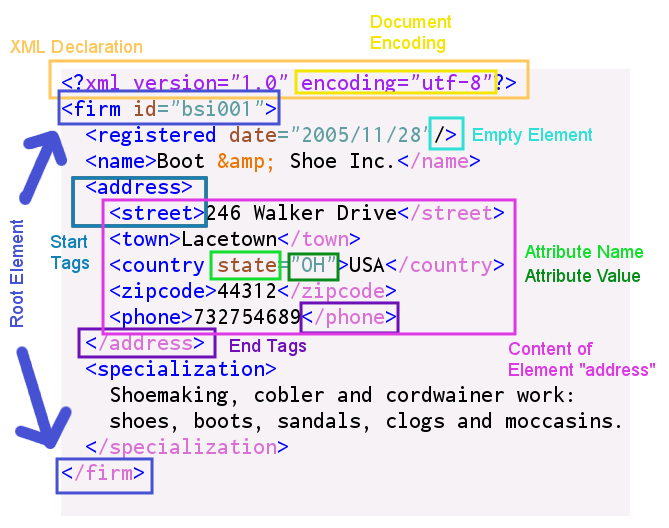Quick Syntax Tour
Terms
|

|
Zdeněk Žabokrtský & Rudolf Rosa
{zabokrtsky,rosa}@ufal.mff.cuni.cz
Tuesday 9.00–11.20
SU2
<firm id="bsi001">
<name>Boot & Shoe Inc.</name>
<address>
<street>246 Walker Drive</street>
<town>Lacetown</town>
<state>OH</state>
<zipcode>44312</zipcode>
<phone>732754689</phone>
</address>
<specialization>
Shoemaking, cobler and cordwainer work: shoes, boots, sandals, clogs and moccasins.
</specialization>
</firm>
Resources: http://www.kosek.cz
| Surname | Firstname | Phone | |
|---|---|---|---|
| Smith | John | jsmith@gmail.com | 2554119897 |
| Walker | David | dwalk@hotmail.com | 8446225653 |
<addressbook>
<person>
<surname>Smith</surname>
<firstname>John</firstname>
<email>jsmith@gmail.com</email>
<phone>2554119897</phone>
</person>
<person>
<surname>Walker</surname>
<firstname>David</firstname>
<email>dwalk@hotmail.com</email>
<phone>8446225653</phone>
</person>
</addressbook>
|

|
XML document can (should) contain instructions for xml processor
Declaration header XML:
<?xml version="1.0" encoding="utf-8" ?>
Document type declaration:
<!DOCTYPE MojeKniha SYSTEM "MojeKniha.DTD">
<!-- Here be dragons -->
(not allowed inside tags, cannot contain --)
the document conforming all syntactic requirements
<!ELEMENT emph (#PCDATA|sub|super)* >
<!ATTLIST author firstname CDATA surname CDATA>
<!ELEMENT collection (description,recipe*)>
<!ELEMENT description ANY>
<!ELEMENT recipe (title,ingredient*,preparation,comment?,nutrition)>
<!ELEMENT title (#PCDATA)>
<!ELEMENT ingredient (ingredient*,preparation)?>
<!ATTLIST ingredient name CDATA #REQUIRED
amount CDATA #IMPLIED
unit CDATA #IMPLIED>
<!ELEMENT preparation (step*)>
<!ELEMENT step (#PCDATA)>
<!ELEMENT comment (#PCDATA)>
<!ELEMENT nutrition EMPTY>
<!ATTLIST nutrition protein CDATA #REQUIRED
carbohydrates CDATA #REQUIRED
fat CDATA #REQUIRED
calories CDATA #REQUIRED
alcohol CDATA #IMPLIED>
xmllint (distributed with libxml)
| NPFL092 | Lecture 9 |